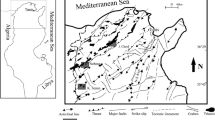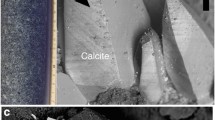Abstract
The 400m thick Lower Permian carbonate sequence of South Sichuan/China, which is considered to be a most important gas reservoir rock, exhibits calcitized gas bubbles and dolomitized burrows which are the result of early diagenesis.
The fossiliferous, highly algal-enriched limestones are part of the Yangtze Platform and are composed of biomicrites, biosparites and calcarenites of subtidal and intertidal environments which underwent a maximum burial depth of some 6000 m.
The calcitized or, rarely, chert-filled gas bubbles represent a morphogenetic series ranging from a slightly brecciated sediment to globular forms and vertically elongated to branched dm-sized vugs; the series contains some internal sediments (lumps, calcarenites) which are identical to the host rock.
Vadose influence is missing. Marcasite aggregates precipitated at the beginning of calcite cement formation emphasize the reducing conditions whereas negative δ13C values (−0.6 to −2.5 ‰) indicate the participation of CO2 and H2O originating from the decay of organic matter. Calcite cements contain reduced amounts of Na. K, Sr, Ba and Mg but are enriched in Fe and Mn in comparison to the host rock.
It is obvious from the data that rising biogenic gases (CH4, CO2, NH3, H2S) under different partial pressures formed the vugs within an unconsolidated sediment (water content approximately 80%).
Burrows parallel to the bedding (typeThalassinoides), which contain biocalcarenites (echinoderm bioclasts) as internal sediment, underwent early diagenetic dolomitization. These dolomites, which rarely developing into dm-thick supratidal beds, document a slight evaporation within the intertidal environments. Surprisingly enough they reveal a slight over abundance of Mg (Ca47Mg53...) which can be explained by an influence of rising formation waters rich in Mg. In comparison to the host rock the dolomites are enriched in Fe, Mn, K, Na, Zn, Pb and As, and exhibit decreased amounts of Ba and Sr as well as slightly higher δ13C values.
The vugs play an insignificant role in respect to reservoir properties, because of their isolated distribution and early cementation which destroyed the pore spaces. By contrast, the recrystallized early diagenetic dolomitized burrows exhibit intercrystalline pores which are often occupied by migrated bitumen, but they are not economically relevant for the reservoir properties of the whole sequence.
Zusammenfassung
In einer etwa 400 m mächtigen unterpermischen Karbonatabfolge Süd-Sichuans/China, die als wichtiger Erdgasspeicher gilt, treten calcitisierte Gasblasen und dolomitisierte Grabgänge als frühdiagenetische Bildungen auf.
Die zur Yangtze-Plattform gehörende Sequenz weist fossilreiche (meist algenreiche) Biomikrite,-sparite und Biokalkarenite sub- und intertidaler Environments aus, die eine maximale Versenkungstiefe von 6000 m erfuhren.
Die calcitisierten oder seltener mit Chert gefüllten Gasblasen lassen von kugeligen über vertikal ausgelängte zu verzweigten Formen eine im dm-Bereich kontinuierliche morphogenetische Reihen erkennen, die mit dem Wirtsgestein identische Internsedimente (lumps, Calcisiltit) enthält.
Während Hinweise auf vadose Einflüsse fehlen, weisen zu Beginn der Calcitzementabscheidung gebildete Markasit-Aggregate auf reduzierende Bedingungen und negative δ13C-Gehalte (−0.6 bis −2,5 ‰) auf eine Beteiligung von CO2 und H2O hin, die bei der Zersetzung organischer Substanz entstanden.
Der Calcit zeigt eine Abreicherung von Na, K, Sr, Ba, Mg und eine Anreicherung von Fe und Mn gegenüber dem Wirtsgestein.
Die ermittelten Daten machen wahrscheinlich, daß aufsteigende biogene Gase (CH4, CO2, NH3, H2S) im noch weichen Kalkschlamm (Wassergehalt ungefähr 80 %) die beschriebenen Hohlräume bei unterschiedlichen Partial-drucken erzeugten.
Schichtgebundene Grabgänge (TypThalassinoides), die Biokalkarenite (Echinodermen) als Internsedimente enthalten, unterlagen einer frühdiagenetischen Dolomitisierung. Diese Dolomite, die sich nur selten zu dm-mächtigen supratidalen Lagen entwickeln, sind Ausdruck geringer Eindampfung in intertidalen Environments; sie weisen jedoch einen leichten Mg-Überschuß (Ca47Mg53...) auf, der durch eine zusätzliche aszendente Mg-Zufuhr zu erklären ist.
Gegenüber dem Wirtsgestein sind die Dolomite durch Fe, Mn, K, Na, Zn, Pb und As an- und durch Ba und Sr abgereichert und außerdem durch höhere δ13C-Gehalte unterschieden.
Als Porenraumlieferanten für thermales Methan spielen die Gasblasen auf Grund ihres isolierten Auftretens und dem frühen Zeitpunkt ihrer Zementation keine Rolle. Die volumenmäßig in unbeschränkten Umfang auftretenden rekristallisierten, frühdiagenetisch dolomitisierten Grabgänge weisen Interkristallin-Poren auf, die meist auch mit Bitumen gefüllt sind. Diese Poren sind für die Speichergesteinsentwicklung der gesamten Sedimentfolge ohne Bedeutung.
Similar content being viewed by others
References
ABED, M.A. & SCHNEIDER, W. (1980): A general aspect in the genesis of nodular limestones documented by the Upper Cretaceous limestones of Jordan.—Sediment. Geol.,26, 329–335, Amsterdam
— (1982): The Cenomanian nodular limestone member of Jordan—from subtidal to supratidal environments.—N. Jb. Geol. Paläont. Monatshefte1982, 513–522, Stuttgart
BERNER, R.A. (1981): A new geochemical classification of sedimentary environments.—J. Sed. Petrol.,51, 359–365, Tulsa
DAI YONGDING, LI JUYING, TIANG XIEGUANG, ZHAO SHENGEAI, HOU KUI, HUANG HUALIANG & XIAO OIYU (1978): Petrography of carbonate rocks from the Permian Maokou and their reservoir properties in Southern Sichuan Basin.—Scienta Geological Sinia3, 1203–219, 6 plates, Beijing
DEFFEYES, K.S., LUCIA, F.J. & WEYL, P.K. (1965): Dolomitization of recent and Plio-Pleistocene sediments by marine evaporite waters on Bonaire, Netherlands Antilles.—Soc. Econ. Paleont. Miner. Spec. Publ.,13, 71–88, Tulsa
DEMAISON, G.J. & MOORE, G. T. (1980): Anoxic environments and oil source bed genesis.—Bull. Am. Assoc. Petr. Geol.,64/8, 1179–1209 Tulsa
DUNHAM, R.J. (1969): Early vadose silt in Towsend mound (reef), New Mexico.—In: FRIEDMAN, G.M. (ed.): Depositional environments in carbonate rocks: A symposium.—Spec. Publ. Soc. Econ. Paleont. Min.,14, 139–181, Tulsa
DUNTON, M.L. & HUNT, J.M. (1962): Distribution of low molecular weight hydrocarbons in recent and ancient sediments.—Bull. Am. Ass. Petr. Geol.,46/12, 2246–2248, Tulsa
ENGELHARDT, W. v., (1977): The origin of sediments and sedimentary rocks.—Sedimentary Petrology III.—359 p., Stuttgart (Schweizerbart)
FÜCHTBAUER, H. (1974): Sediments and sedimentary rocks 1, Sed. Petrology II.—464 p. Stuttgart (Schweizerbart)
FÜRSICH, F.T. (1973):Thalassinoides and the origin of nodular limestone in the Corallian Beds (Upper Jurassic) of southern England.—N. Jb. Geol. Paläont. Monatshefte1973, 136–156, Stuttgart
HOEFS, J. (1980): Stable isotope geochemistry.—Minerals and Rocks9, 203 p. Berlin (Springer)
ILLING, L. v., WELLS, A.J. & TAYLOR, J.C.M. (1965): Penecontemporary dolomite in Persian Gulf.—Soc. Econ. Paleont. Min. Spec. Publ.13, 89–111, Tulsa
KELTS, K.R. & McKENZIE, J.A. (1982): Diagenetic dolomite formation in Quarternary anoxic diatomaceous muds of Deep Sea Drilling Project Leg 64, Gulf of California.—Initial Reports Deep Sea Drilling Projekt,64, 553–569, Washington
LAND, L.S. & EPSTEIN, S. (1970): Late Pleistocene diagenesis and dolomitization, north Jamaica.—Sedimentology,14, 187–200, Amsterdam
LAND, L.S. (1971): Phreatic versus meteoric diagenesis of limestones: evidence from a fossil water table in Bermuda.—In: BRICKER, O.P. (ed.): Carbonate cements. —Johns Hopkins Univ. Stud. Geol.,19, 133–136, Baltimore
LIPPMANN, F. (1973): Sedimentary carbonate minerals.— Minerals, Rocks and Inorganic Materials,6, 228 p. Berlin (Springer)
LIU XIAOZENG, SCHNEIDER, W. & TAN WENBIN (1988 a): Lower Permian limestones as source and reservoir rocks for thermal gas in South Sichuan/China.—Oil and Gas (in press)
LIU XIAOZENG, (1988b): Talc mineralization and chert/carbonate concretions as diagenetic patterns related to increased heat flow in hydrocarbon-bearing Lower Permian biocalcarenites of South Sichuan, China.—N. Jb. Geol. Paläont. Monatshefte (in press)
MORROW, W.D. (1978): Dolomitization of Lower Paleozoic burrow-fillings.—J. Sediment. Petrol.,48, 269–280, Tulsa
PENG DA-JUN (1985): General geological situation in South Sichuan.—Writt. Comm., 21 p., College of Geology, Chengdu, Sichuan, China
SHINN, E.A. (1968): Burrowing in recent lime sediments of Florida and the Bahamas.—J. Paleont.42, 879–894, Tulsa
SMITH, P.V., Jr. (1954): Studies on origin of petroleum: Occurrence of hydrocarbons in recent sediments.—Bull. Am. Assoc. Petrol. Geol.,38/3, 377–404, Tulsa
TISSOT, B.P. & WELTE, D.H. (1978): Petroleum formation and occurrence.—538 p., 243 Figs., Berlin (Springer)
VEIZER, J. & HOEFS, J. (1976): The nature of δ18O/16O and δ13C/12C secular trends in sedimentary corbonate rocks.—Geochim. Cosmochim. Acta,40, 1387–1395, London
YANG ZUNYI, CHENG YUQI & WANG HONGZHEN (1986): The Geology of China.—Oxford monographs on Geology & Geophysics,3, 303 p., Oxford (Clarendon Press)
Author information
Authors and Affiliations
Rights and permissions
About this article
Cite this article
Xiaozeng, L., Schneider, W. & Wenbin, T. Biogenic methane and burrowing as important controlling factors in the early diagenesis of permian carbonate rocks in South Sichuan/China. Facies 18, 289–301 (1988). https://doi.org/10.1007/BF02536803
Received:
Revised:
Issue Date:
DOI: https://doi.org/10.1007/BF02536803




